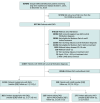Left Atrial Appendage Occlusion vs Anticoagulants in Dialysis With Atrial Fibrillation
- PMID: 40924421
- PMCID: PMC12421340
- DOI: 10.1001/jamanetworkopen.2025.30990
Left Atrial Appendage Occlusion vs Anticoagulants in Dialysis With Atrial Fibrillation
Erratum in
-
Error in Byline.JAMA Netw Open. 2025 Oct 1;8(10):e2543432. doi: 10.1001/jamanetworkopen.2025.43432. JAMA Netw Open. 2025. PMID: 41114983 Free PMC article. No abstract available.
Abstract
Importance: Patients with kidney failure (KF) receiving long-term dialysis have increased incidence of atrial fibrillation (AF). Patients with KF and AF have increased risk of stroke, death, and bleeding compared with age-matched cohorts. In KF, the use of oral anticoagulants (OACs) increases hemorrhage risk, offsetting potential benefits and making left atrial appendage occlusion (LAAO) a potentially promising solution for risk reduction in AF.
Objectives: To compare the outcomes and safety of OACs and LAAO for risk reduction of AF in patients with KF.
Design, setting, and participants: This retrospective cohort study assessed patients with KF enrolled in the US Renal Data System registry between January 1, 2015, and December 31, 2018, who were diagnosed with AF after initiation of long-term dialysis. On average, patients met inclusion criteria for 22 months. Data analysis was completed in May 2024.
Exposure: Medicare claims were used to identify patients who received OACs and LAAO after AF diagnosis. A propensity-matched cohort was created based on the CHA2DS2-VASc score and year of treatment.
Main outcomes and measures: Death, nonfatal bleeds, and nonfatal strokes.
Results: The final cohort included 2344 patients with KF and a new AF diagnosis (median [IQR] age, 66.0 [57.0-73.0] years; 1341 [57.2%] male). Of these patients, 293 received LAAO and 2051 received OACs. A total of 2194 patients (93.6%) were receiving hemodialysis, with the remaining 150 (6.4%) receiving peritoneal dialysis. In the LAAO group, 79 deaths (27.0%) and 21 nonfatal strokes (7.2%) occurred, and 117 patients (39.9%) experienced 234 bleeding events. In the OAC group, 729 deaths (35.5%) and 163 strokes (8.0%) occurred, and 687 patients (33.5%) experienced 1114 bleeding events. After accounting for correlation between bleeds and death, the joint frailty model showed evidence of a treatment association of LAAO compared with OACs on recurrent bleeding events (hazard ratio [HR], 0.74; 95% CI, 0.56-0.98) and death (HR, 0.47; 95% CI, 0.30-0.72). There was a reduced risk of nonfatal stroke in the LAAO group (HR, 0.55; 95% CI, 0.32-0.94), but this finding was not significant after adjustment (HR, 1.18; 95% CI, 0.76-1.81).
Conclusions and relevance: In this cohort study, LAAO compared with OACs was associated with improved survival and reduced bleeding risk in patients with KF and AF. These findings suggest that these data should be considered in shared decision-making in consideration of LAAO for patients with KF and AF.
Conflict of interest statement
Figures


References
-
- Benjamin EJ, Blaha MJ, Chiuve SE, et al. ; American Heart Association Statistics Committee and Stroke Statistics Subcommittee . Heart disease and stroke statistics-2017 update: a report from the American Heart Association. Circulation. 2017;135(10):e146-e603. doi: 10.1161/CIR.0000000000000485 - DOI - PMC - PubMed
-
- Joglar JA, Chung MK, Armbruster AL, et al. ; Peer Review Committee Members . 2023 ACC/AHA/ACCP/HRS Guideline for the Diagnosis and Management of Atrial Fibrillation: a report of the American College of Cardiology/American Heart Association Joint Committee on Clinical Practice Guidelines. Circulation. 2024;149(1):e1-e156. doi: 10.1161/CIR.0000000000001193 - DOI - PMC - PubMed
-
- U.S. Renal Data System . 2020 USRDS Annual Data Report: Epidemiology of Kidney Disease in the United States. National Institutes of Health, National Institute of Diabetes and Digestive and Kidney Diseases; 2020.
Publication types
MeSH terms
Substances
LinkOut - more resources
Full Text Sources
Medical
Miscellaneous

